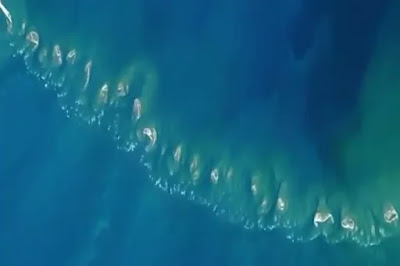Copyright © Arth Chakraborty
All Of The Happenings Menitioned In Ramayana Or Any Other Script Of Hinduism Is Not A Mythology But Is Rather A Part Of History!
First of all, it is absolutely unjust to call Ram Setu as Adam's Bridge. So, Ram Setu or Raam's Birdge is a chain of limestone shoals, between Rameswaram Island, off the south-eastern coast of Tamil Nadu, India, and Mannar Island, off the north-western coast of Sri Lanka. Geological evidence suggests that this bridge is a former land connection between India and Sri Lanka.
 |
| NASA satellite photo: India on top, Sri Lanka at the bottom |
The setu(bridge) is 48 km(30 mi) long and separates the Gulf of Mannar (south-west) from the Palk Strait (northeast). Some of the regions are dry, and the sea in the area rarely exceeds 1 metre (3 ft) in depth, thus hindering navigation. It was reportedly passable on foot until the 15th century when storms deepened the channel. Rameshwaram temple records say that Adam's Bridge was entirely above sea level until it broke in a cyclone in 1480.
 |
| Rock Formation Of Ram Setu |
The ancient Indian Sanskrit Epic Ramayana that took place 1.6 million or 16 lakh years ago was written by Sage Valmiki. He mentions a bridge structure that is of supernatural origin, constructed by Vanara Sena(army of intelligent warrior monkeys or ape-men) to aid Rama to reach Lanka and rescue his wife Sita from the Rakshasa king, Raavana; who had kidnapped her. Led by Nila and under the engineering direction of Nala, the vanaras constructed a bridge to Lanka in five days. The bridge is also called Nala Setu, the bridge of Nala. The location of the Lanka of the Ramayana has been widely interpreted as being current day Sri Lanka making this stretch of land or Rama's bridge.
Facts That Prove Ramayana Existed:-

Hanuman Burns Lanka in Sundar Kaand
 |
| Gompjothere Elephants With 2, 3 and 4 Tusks |
- Modern anthropologists say that elephants with four tusks existed 12-1.6 million years ago.
- The Gomphotheriidae were a diverse taxonomic family of extinct elephant-like animals (proboscideans). Referred to as gomphotheres, they were widespread in North America during the Miocene and Pliocene epochs, 12-1.6 million years ago. Some lived in parts of Eurasia, Beringia and, following the Great American Interchange, South America.
- Gomphotheres differed from elephants in their tooth structure, particularly the chewing surfaces on the molar teeth. Most had four tusks, and their retracted facial and nasal bones prompt palaeontologists to believe that gomphotheres had elephant-like trunks.
- Though the Archaeological Survey of India(ASI) found no evidence for the structure being human-made and the ASI along with the government of India informed the Supreme Court of India in a 2007 affidavit that there was no historical proof of the bridge being built by Rama. But there are contradictory statements of ASI about the reasearch made by them on Ram-Setu.
- The Rameshwaram island evolved approximately 1,25,000 years Before Present(BP).
- Rock and Soil samples show that the same being from the Upper Miocene period.
According to Our Research, We have found out that Upper Micoene or Late Miocene Period Existed 11.63 Ma (million years ago) to 5.333 Ma. Vedic Period & Ancient Indian History as well as Hindu time chronology has scripts that talk about super natural powers and gods. Therefore, Ramayan Existed and there are quite a lot of evidences of Ram-Setu being made by Lord Rama and the great monkey.







0 Comments